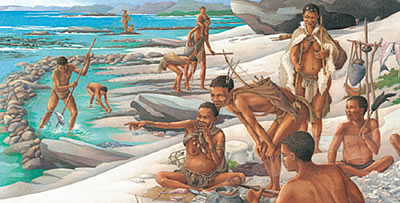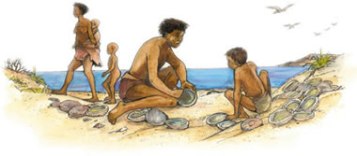Strandlopers and river apes

 It is interesting that so many of the oldest sites of modern human remains is coastal, for instance; Klaasies River Mouth (Tsitsikamma Coast – South Africa), Border Cave (Indian Ocean Coast – South Africa), Omo I & II (ancient Omo River delta where it once entered Lake Turkana – Ethiopia).
It is interesting that so many of the oldest sites of modern human remains is coastal, for instance; Klaasies River Mouth (Tsitsikamma Coast – South Africa), Border Cave (Indian Ocean Coast – South Africa), Omo I & II (ancient Omo River delta where it once entered Lake Turkana – Ethiopia).
The idea that humans evolved in close proximity to water has been dubbed the ‘Aquatic Ape Theory’. Even though this theory might be over-stating the case I believe it should not be ignored out of hand. The evidence of early shell middens (Klaasies River & Hoedjiespunt – 40 000-120 000 bp) associated with the earliest of humans proves that (at least some) humans lived from the bounty of the oceans and lakes. Interesting also is that the oldest evidence of human beautification is that of sea-shell beads.
The evidence of early shell middens (Klaasies River & Hoedjiespunt – 40 000-120 000 bp) associated with the earliest of humans proves that (at least some) humans lived from the bounty of the oceans and lakes. Interesting also is that the oldest evidence of human beautification is that of sea-shell beads.
One can imagine a scenario of bands of people living very much like the ‘strandlopers’ (trans. ‘beachwalkers’ – a people that have been living along the Cape coast when the first european explorers arrived in the 17th century) that getting the best of both worlds – terrestrial and aquatic.
Unfortunately coastal areas does not get preserved well through the ages. Still there is quite a bit if evidence that human had a maritime lifestyle going back for at least 10,000 years according to Professor Jon Erlandson. According to him the maritime capabilities of ancient humans have been greatly underestimated. See this article on BBC on coastal humans.
There is some interesting correlations between adaptations for an amphibious lifestyle and speaking in languages:
-
 Fine control over our breathing – It might be possible that our fine breathing control could initially have evolved to allow us to dive under water rather than for vocalisation. There is indication that this fine control evolved with later homo Erectus. The practice of Pranayama whereby higher states of consciousness is achieved through breathing exercises might very well have an evolutionary dimension in the origin of religious experience.
Fine control over our breathing – It might be possible that our fine breathing control could initially have evolved to allow us to dive under water rather than for vocalisation. There is indication that this fine control evolved with later homo Erectus. The practice of Pranayama whereby higher states of consciousness is achieved through breathing exercises might very well have an evolutionary dimension in the origin of religious experience. -
The easy life – The richness of marine food sources could have implied an easing up of the ‘struggle’ for survival. Living in superabundance would free up a lot of time for making music, dancing, singing AND telling stories. Having free time to experiment with life must have been a very powerful impetus for cultural evolution. Of course marine diet is not the only explanation for a state of superabundance.
BUT there is another explanation for most of the features attributed to us being amphibious; and that is that our immature form took evolutionary precedence – neotony. The classic example of neotony is that of the Axolotl: a salamander who’s aquatic larval form became the evolutionary successfull form without the individuals ever metamorphosising into a into a terrestrial adult form. In my mind one should consider both these explanations. This kind of neotony also occurs with domesticated animals where a domestic dog is none other than a neotony of a wolf. In this sense we humans are nothing but domesticated apes. (I say this tongue-in-cheek as we probably selected for cuteness in breeding our domestic animals).

October 23, 2007 at 6:23 pm
Just read an interesting post about homo living in cliff caves next to water. We do seem to be excellent climbers as well as swimmers.
July 1, 2008 at 6:05 pm
I am most interested in the two ‘strandloper’ illustrations that appear in the above article, ‘Strandlopers and river apes’. Does anyone know where I could see more of this work? Who is he artist?
Thanks in anticipation,
Michael
August 8, 2008 at 9:02 pm
[…] Strandlopers or Beachcomers here illustrated below, disappeared on […]
November 28, 2008 at 1:17 pm
I strongly believe in the aquatic ape theory. Living on the dry savanna cannot explain bipedalism, loss of hair, or body fat.
February 11, 2009 at 6:53 am
I have a theory based on Gavin Menzie’s book ‘1421’ that the people called STRANDLOPERS found along the Cape coast were actually shipwrecked Chinese who plus-minus 140 or so years before the first Europeans circumnavigated the Cape of Good Hope had got stranded (excuse the pun!) and became the coast hugging “Strandlopers” waiting in vain for their people to return, which of course they never did. Interestingly world wide these stranded ones planted trees with votive statuettes under their roots. I believe one is on False Bay at Windmill Beach near Boulders Beach Simon’s Town where there is a huge Jackass Penguin population and the remains of middens over which a golf course is built now. There is also evidence that a type of ancient oats was planted in this area long ago….
February 19, 2009 at 9:07 am
I NOW THEN THAT PEOPLE FOR LONG TIME DID LIVE IN ANGOLA NEAR THE BEACH IN ONE AREA OF TIGER BAY, IN IONA PARC.PEOPLE OF THERE SAID THEN THEY WERE EATING SEAL AND FISH. THIS PEOPLE WERE EXTERMINE FOR ANOTHERS PEOPLE CAME FROM SOUTH AFRICA.THE OLD PEOPLE OF THAT AREA SAY THEN STRANDLOPERS WAS THE SMALL ESTACTUR AND BECAUSE THE HABIT OF LIVE ALONG THE BEACHE, AND THE MONTANHA, YOUR HABITAT WAS LIKE THE NEVOEIRO, AND THE PEOPLE CAAL:PEOPLE OF NEVOEIRO;OR MACAROMBOLOS(BECAUSE THEY DID USUALLY STANDING EARL)THEY USUALLY SAY THEM THE NAME OF OTHERS PEOPLE KILLED
WAS THE BASTARS.
March 11, 2009 at 9:55 am
Hello
I am looking for some of the pictures above to use for a documentary called Shoreline on the coast of South Africa. Please could someone tell me who I could contact about this? Thank you